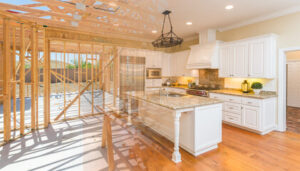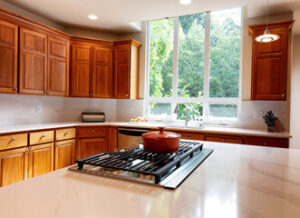Cabinet Refacing Sacramento CA is a quick and affordable way to upgrade your kitchen. It can be completed within days, compared to the weeks or months required for a full renovation.

Refacing is also a more eco-friendly choice than tearing out your old cabinets and replacing them with new ones. This option prevents waste and pollution from entering the environment.
Cabinet refacing is typically cheaper than complete cabinet replacement and requires less labor. It also allows homeowners to update their kitchen without breaking the bank, boosting their home’s value. However, there are a few things to consider before embarking on a refacing project.
First, consider the materials you want to use. Cabinet refacing contractors can help you select from a variety of colors, styles, and finishes to fit your design preferences. They’ll also discuss maintenance requirements, as each material has its own unique needs.
Wood veneer is an economical option that’s available in a range of species. It can be stained or painted to create a custom look, and it’s durable enough for frequent use. However, it’s not as resistant to moisture as other options, such as acrylic.
Another cost-effective option is Rigid Thermofoil (RTF). This thin vinyl film is applied to medium-density fiberboard (MDF), offering a sleek and uniform appearance. It’s available in a wide variety of colors and patterns, including those that mimic wood grain, giving homeowners a lot of flexibility with their design choices. It’s important to note that Rigid Thermofoil isn’t as durable as solid wood, and it can be prone to peeling.
Before refacing your cabinets, you’ll need to remove all of the existing hardware and sand down the surface to ensure a smooth finish. Then, your contractor will install the new doors and drawer fronts. You can opt for a simple, clean look or a more elaborate style, transforming your room into the modern kitchen of your dreams.
Whether you choose wood veneer, Rigid Thermofoil, or acrylic, the cost of your new cabinets will vary depending on your location. Be sure to compare quotes from reputable professionals to get the best price for your project. Lastly, don’t forget to factor in the cost of new cabinet hardware. While it’s not necessary, many homeowners choose to replace their knobs and pulls to match their new cabinets. This can add an extra pop of color or complement their new design, bringing the entire space together.
Materials
Choosing the right cabinet refacing material is essential to the final aesthetic and functionality of your kitchen. There are a variety of options available, including wood veneers, laminates, and thermofoil. The best choice depends on your budget, lifestyle, and style preferences. A professional cabinet refacing company can help you choose the right materials for your remodel.
Real wood veneers are a popular choice for cabinet refacing because they offer durability and beauty. They are available in a wide variety of species and stain colors. Additionally, they are resistant to heat and moisture. However, wood veneers are more expensive than other types of refacing materials.
Laminates are a cost-effective option that offers a variety of color, pattern, and texture options. They are suitable for refacing cabinets, countertops, and drawer fronts. They are also durable and easy to clean. They can be used to create a modern or traditional design. However, laminates are susceptible to water exposure and can warp over time.
Thermofoil is a flexible vinyl material bonded to medium-density fiberboard (MDF) surfaces using heat and vacuum pressure. It is a popular choice for kitchen cabinet refacing because it is a versatile and durable material that can be molded into different shapes. It is also resistant to moisture and heat and can be wiped down easily.
Before starting the cabinet refacing process, it is important to clear out your workspace and protect the surrounding surfaces. It is also necessary to shut off the power and water to prevent any damage during the installation process. This step will ensure a safe and successful renovation.
The cabinet refacing process can be completed in just a few days. Refacing is a faster and cheaper option than replacing cabinets because it preserves the existing structure of the room. It is also environmentally friendly, as it reduces waste and the amount of new materials needed for the project. A cabinet refacing contractor can help you select the right material for your space, and install it quickly and efficiently. They can even replace your hardware to complete the look.
Installation
Refacing cabinet doors and drawer fronts adds a new look to a kitchen while maintaining the existing structure. The process also offers an opportunity to address any minor structural issues that may be present. In addition, refacing keeps plumbing, electrical, and gas connections intact, which can save money compared to a complete cabinet replacement. Additionally, cabinet refacing can boost resale value and make the home more appealing to prospective buyers.
Depending on the contractor and project specifications, homeowners can choose from a variety of materials to complement the new aesthetic. Popular options include paint, laminate sheets, or veneers. These materials can be installed over the existing cabinet boxes or applied directly to them. Additionally, the refacing process can include updating hardware such as handles, knobs, and hinges to match the new look.
A professional can help homeowners navigate customization options and ensure the finished result aligns with their design preferences. They can also take precise measurements and account for nuances in cabinet dimensions and layouts, which can prevent mistakes during installation. Additionally, experienced handymen have problem-solving abilities and can quickly resolve unexpected challenges that may arise during the project.
While a DIY approach can offer a sense of accomplishment and potential cost savings, it can be difficult to achieve quality results without the proper tools or skills. Moreover, DIY projects often involve handling dangerous chemicals and equipment that can pose health risks if not properly handled. Hiring a professional for a cabinet refacing project eliminates these hazards and provides peace of mind that the work will be performed safely and efficiently.
Whether a homeowner opts for a DIY or professional cabinet refacing project, the results should meet their expectations and provide long-lasting satisfaction. However, it is crucial to research contractors carefully to ensure that they are qualified and capable of meeting project requirements. Negative reviews and complaints should be taken seriously as they could signal subpar workmanship or hidden costs. Moreover, a low estimate can be a red flag that the contractor is using subpar materials or taking shortcuts in the installation process.
Warranty
Cabinet refacing is a great way to give your home a fresh new look and increase its value. It is also more affordable than a complete kitchen renovation and can be completed in just a few days. However, it is important to understand the differences between refacing and refinishing cabinets before you get started. Both options have their advantages, but refinishing is best for those who prefer to maintain the natural wood color of existing cabinets. Refacing, on the other hand, allows you to choose from a wide variety of styles and colors, ensuring that your new kitchen will match your vision exactly.
A botched DIY cabinet refacing project can have serious consequences. Not only can it detract from the overall appeal of your kitchen, but it could void any warranty that may be on your cabinets or your home. In addition, improper use of adhesives and paints can lead to health risks. Choosing a professional for this project will ensure that your work is done properly and will not cause any issues in the future.
When refacing cabinets, you can choose from several different materials for the door and drawer fronts. The most common choice is thermofoil, which is easy to clean and offers a variety of style options. Solid wood is another option, but it is expensive and requires more maintenance.
The cabinet refacing process involves replacing the cabinet doors, drawer fronts, and hardware while keeping the cabinet boxes intact. The boxes can be made from wood, MDF, or other material, but they must be durable and able to support the weight of the new cabinet materials. When using high-quality materials and craftsmanship, a refaced kitchen can last just as long as a brand-new kitchen.
Compared to a full kitchen remodel, cabinet refacing is a more environmentally friendly solution. It saves resources and reduces the amount of waste produced by tearing out and replacing existing cabinets. It can also be completed in a shorter period of time, saving you money and reducing disruption to your daily life.

